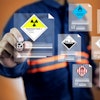The safe handling of hazardous materials continues to be a widely publicized challenge facing manufacturers, government agencies and commercial organizations across our nation. Even the smallest contamination leak can spell the most drastic consequences, such as hefty clean-up costs, stringent fines, legal fees and significant long-term implications on operational efficiency.
Since the September 11 attacks, fears of bio-terrorism have become reality, posing threats going well beyond traditional hazardous materials. Our mail system has seen it all — from the anthrax attacks of 2001 to other high-profile events — alerting us that mail, like other common sources of contamination, needs to be handled with the highest level of responsibility.
In the face of these threats, companies must be prepared to build significant capabilities to determine the presence, or absence, of suspicious or obvious bio-threat material in letters, flats, parcels and packages delivered by the USPS, Federal Express, the United Parcel Service and other commercial carriers in order to safeguard the organization and its staff.
The Pentagon is leading the way in mail sanitation best practices. It currently employs unique, rigorous operations and technology aimed at constructing a robust fortress around all forms of chemical and biological agents. These steps are needed to ensure that the safety of facilities — and the way of life within those facilities — isn't compromised in any shape or form. This article addresses current best practices and the underlying technologies for handling hazardous materials.
Best Practices Bringing Regulations to the Forefront
Title 49 of the Code of Federal Regulations (CFR) 100-185 explicitly provides guidance and establishes regulations for the safe and secure transportation and logistics of hazardous materials, including packaging, marking, transport, loading and unloading. These regulations apply to anyone moving hazardous material in a package by any means of transport.
To comply with the present regulations, many precautions are necessary for handling and transporting hazardous material. The need to be identified by appropriate placards is highly essential: Personnel handling hazardous materials should have access to material safety data sheets (MSDS) along with emergency response procedures providing guidance in the case of contamination.
Federal regulations require Level C personal protective equipment (PPE) for all personnel in a sort/pre-wrap area, including a full body Tyvek suit with hood, Tyvek shoe covers, powered air purifying respirator (PAPR) with HEPA filter and Nitrile gloves draping surgical gloves. All incoming items must go through a rigorous process to ensure when the item leaves mail/freight processing areas it is no longer considered a contaminated threat to the remainder of the facilities. During this phase, items are bar-coded to ensure accurate tracking during processing and proper storage of pertinent data through ultimate delivery.
DAAMS, MINICAMS and ACADA
Items received from many commercial or government carriers are scanned for all types of hazards, including — but not limited to — toxic chemicals, microbiologicals (pathogenic and non-pathogenic), toxins, radioactive materials, explosives/pyrotechnics, lasers, X-ray devices or any other substance or equipment that is a potential hazard. These items should be handled in a separate and isolated processing area, initially bagged and decontaminated using a bleach solution. Depot area air monitoring system (DAAMS) equipment is used to sample the processing area for possible chemical and biological contaminants while the item is isolated. The bagged contents should then be X-rayed to ensure the absence of explosive threats.
After the item is X-rayed, it should be transferred to a chemical fume hood for opening. The miniature continuous air monitoring system (MINICAMS) is a real-time chemical detector located within the hood to sample the air for contaminants. Meanwhile, the area around the fume hoods is simultaneously tested for chemical threats by an automatic chemical agent alarm (ACADA) system. After an item is opened and cleared as free from contamination, it is again bagged and decontaminated for another layer of testing — and then stored for two days while chemical and biological samples are analyzed by a laboratory and deemed to be "all clear."
After notification is received that the items do not possess any chemical, biological, radiological, nuclear or explosive threats, they need to be distributed to intended recipients in accordance with U.S. Postal Service (USPS) regulations (39CFR24) and federal transportation regulations (49CFR100-185).
Comprehensive database and tracking systems are used to seamlessly track an item, with all information being archived to improve handling and data gathering for investigatory procedures. All waste generated within facilities, as well as clothing and personal protective equipment, is deemed potentially contaminated. This accumulated waste should be boxed and shipped as medical waste through various contractors to its final location, where it is burned.
Maximizing Safety Investments
To ensure the safety of both clients and staff, organizations must be prepared to make a considerable investment in time, materials and finances. Unlike other processes and procedures shown to save a percentage of operating costs, reduce manpower or result in cost savings, hazardous material handling and mail decontamination procedures are highly preventive and may increase costs on paper.
But in these situations, safety is money: A single incident of contamination within an organization's facility by anthrax or other biological threats could result in a complete "shut down." Buildings could be closed for months — and thousands of dollars could be lost:
- After an anthrax attack in 2001, the Hart Senate Office Building shut down for dozens of days, accumulating more than $14 million of cleanup costs.
- Anthrax-contaminated mail discovered in Washington, D.C., and New Jersey shut down USPS facilities in both cities and required months of testing for both workers and facilities for contamination.
- The Capitol complex was completely shut down for 11 days after a bio-terrorism attack.
- Nearly 10,000 workers in New Jersey and New York received preventive medical treatment in the wake of anthrax scares.
When lost productivity due to a "shut down" or even an incident is considered, product management becomes a realistic alternative to saving a simple dollar in the near term. Ultimately, implementing "safemail" and "safefreight" decontamination procedures is not about saving a few dollars or reducing costs — it is about preventing catastrophe and ensuring the survival of organizations involved in the logistical transport, processing and delivery of mail and freight.
About the Author: Tom Bauer is senior vice president for operations for Dayton-based SoBran. He can be reached at [email protected] .
















